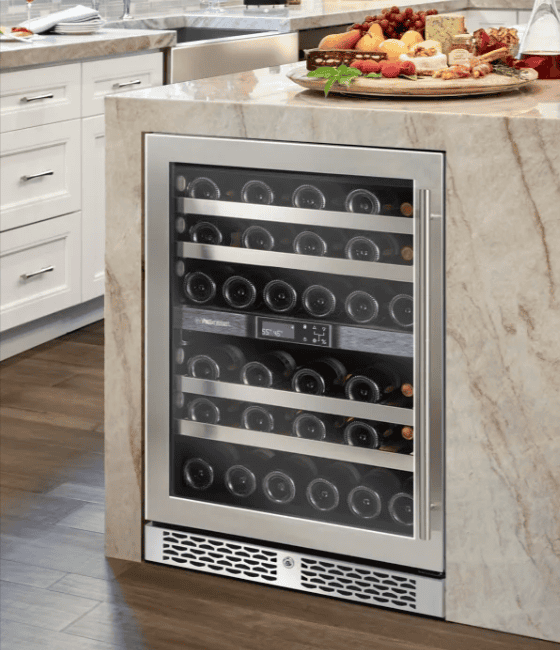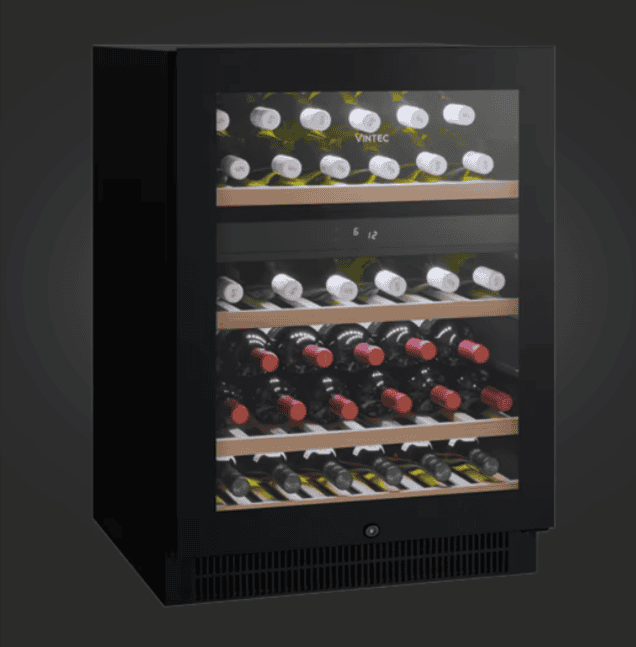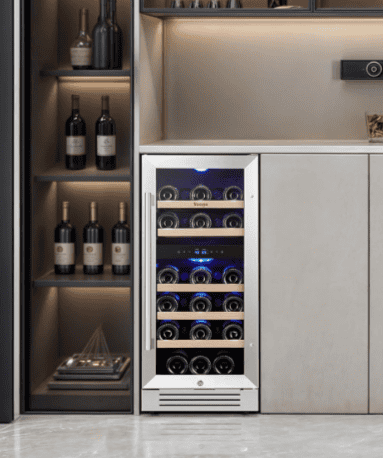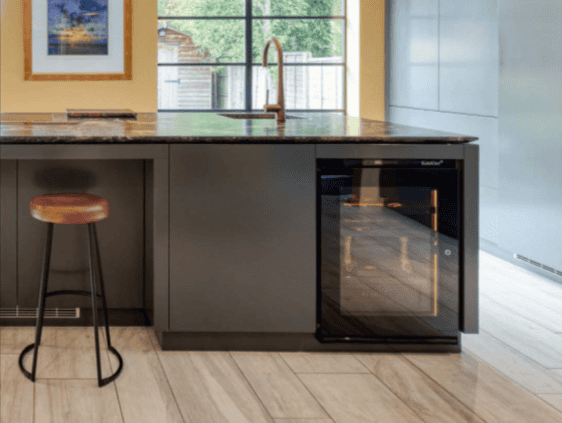Did you know that properly stored wine can increase in value by 10-15% annually?
As wine collecting becomes increasingly popular, homeowners are seeking sophisticated storage solutions that don’t compromise their kitchen’s aesthetic. Under-counter wine refrigerators offer the perfect blend of functionality and style, providing optimal storage conditions while maximizing your kitchen space.
I’ve spent countless hours reviewing the latest models to bring you this comprehensive guide to the best under-counter wine fridges of 2025!
Welcome to Didi Somm and Cheers!
Important Notice: The information in this article is for general and public information purposes only. It solely reflects Didi Somm’s or his Staff’s opinion, and no responsibility can be assumed for errors or omissions in the service’s contents. For details, please check the Disclaimer at the bottom of the homepage.
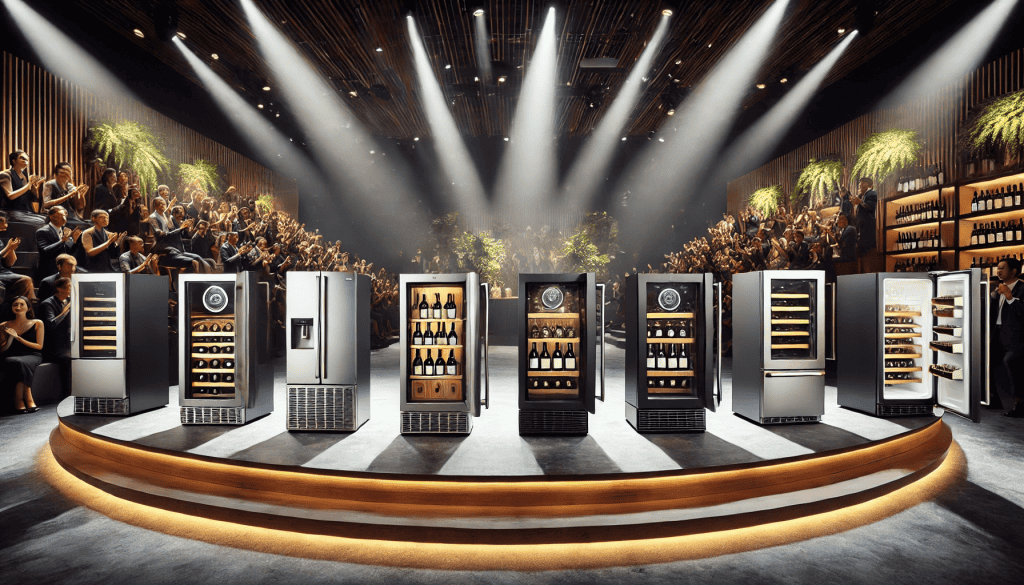
Key Takeaways
- Under-counter wine refrigerators maintain ideal temperature and humidity levels for wine preservation
- Built-in units require proper ventilation and specific installation considerations
- Prices range from $800 to $3,000+ depending on capacity and features
- Dual-zone temperature control is essential for storing both red and white wines
- Professional installation is recommended for optimal performance and warranty coverage
Affiliate Disclaimer: This page may include Affiliate links, meaning that we get a commission if you decide to purchase through this site at no extra cost to you. Please read our Disclaimer for your info.
Understanding Under-Counter Wine Refrigerator Basics
Let me tell you about my journey into the world of under-counter wine refrigerators – it’s been quite the learning experience!
Difference Between Built-in and Free-standing Units
When I first started exploring built-in wine storage options, I actually made the rookie mistake of trying to install a freestanding unit under my counter. Big yikes! That’s when I learned the crucial difference between built-in and freestanding units:
- Built-in models have front ventilation systems
- Freestanding units need space on all sides for proper airflow
Dimensions
Speaking of space, let’s talk dimensions. Most under-counter wine fridges are designed to fit standard cabinet openings, typically 24 inches wide and 34-35 inches high. I’ve found that depth is where you really need to pay attention – you’ll want about 24 inches minimum to accommodate standard wine bottles, plus a little wiggle room for the door and hinges. Trust me on this one – I once had to return a unit because I forgot to account for the door handle depth!
Ventilation
Ventilation is absolutely critical for these units. After helping dozens of homeowners with their wine storage setups, I’ve learned that you need at least 2 inches of clearance at the back and sides for built-in units. The front-venting system is what makes under-counter models special – it releases heat through the front grille, just like your dishwasher does.
Under-Counter Type – Advantages
Compared to standard wine coolers, under-counter models offer some serious advantages. They seamlessly integrate into your kitchen design (no more bulky standalone units!), and they’re built to handle the higher ambient temperatures that come with being surrounded by cabinetry. Plus, they typically have more robust cooling systems.
Energy Efficiency
When it comes to energy efficiency, most modern under-counter wine fridges use around 100-200 watts, similar to a standard light bulb. I monitor my energy usage pretty carefully, and I’ve found that my unit adds about $8-12 to my monthly electric bill. Look for “Energy Star-certified” models – they use about 10% less energy than standard units.
Key Features to Consider When Choosing an Under-Counter Wine Fridge
After spending years helping people select the perfect wine storage solution, I’ve learned that temperature control is the make-or-break feature of any good wine fridge. I remember one client who lost several expensive bottles because their single-zone unit couldn’t maintain consistent temperatures. That’s why I always recommend dual-zone systems – they let you store reds at 55-65°F and whites at 45-55°F simultaneously.
Humidity management is another crucial factor that often gets overlooked. You want humidity levels between 50-70% to keep those corks from drying out. I learned this lesson the hard way when I stored some precious Bordeaux in a unit without humidity control. The corks dried out, and… well, let’s just say it wasn’t pretty!
The importance of UV protection cannot be overstated. Most quality units now come with UV-protected glass doors and LED lighting. These features aren’t just for show – UV rays can seriously damage wine by causing premature aging and off-flavors. The LED lighting is also much gentler on your wines compared to traditional bulbs, plus they look pretty snazzy!
When it comes to storage capacity, think carefully about your needs. Standard under-counter units typically hold 30-50 bottles, but here’s a pro tip: always go bigger than you think you need. I’ve never met anyone who regretted having extra storage space! The shelf configuration is crucial too – look for adjustable wooden shelves that can accommodate different bottle sizes.
One aspect that surprised me when I first started working with wine fridges was the importance of vibration control. Even minor vibrations can disturb the sediment in wine and affect its aging process. The best units use special compression systems and vibration-dampening features to keep things nice and still. As for noise levels, aim for units that operate at 40 decibels or less – about as quiet as a library.
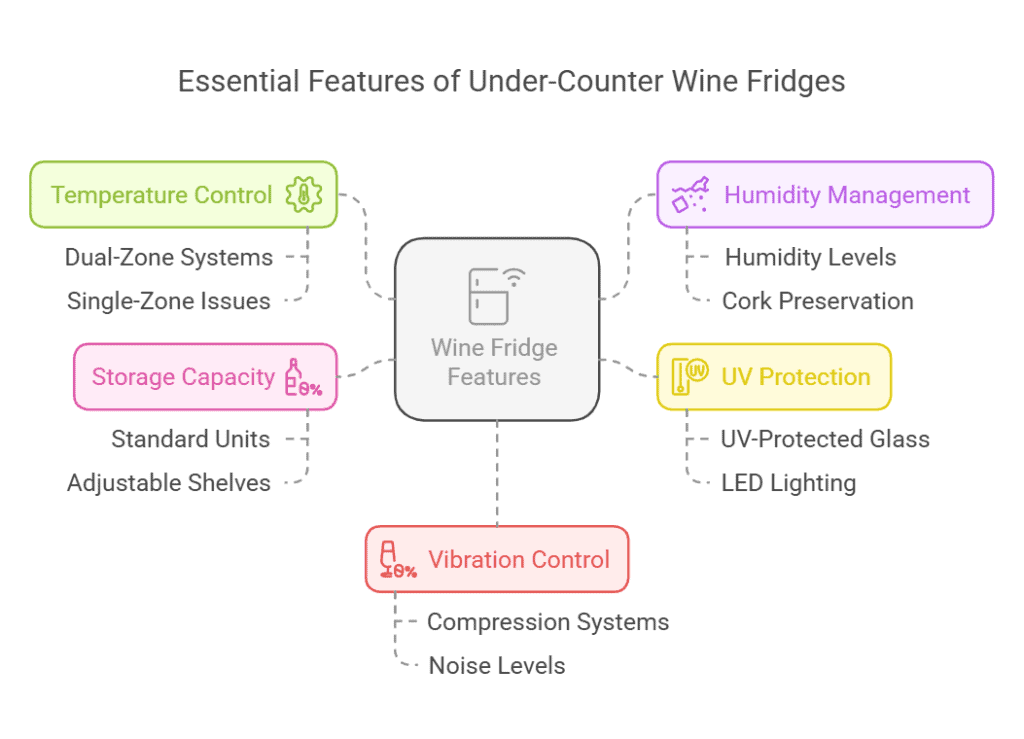
Top 5 Under-Counter Wine Refrigerators of 2025
After reviewing dozens of models and collecting feedback from numerous wine enthusiasts, I’ve put together what I believe are the absolute best under-counter wine refrigerators for 2025. Let me walk you through my top picks!
Wine Enthusiast Prestige S 24″ Dual-Zone “smart” Wine Cellar
Our best overall choice is the Wine Enthusiast Prestige S 24″ Dual Zone Undercounter Smart Wi-Fi Wine Cellar. It consistently impresses with its 46-bottle capacity in a standard 24-inch width. The dual-zone temperature control is incredibly precise, maintaining zones between 41-68°F with zero fluctuation. With the built-in Wi-Fi and Wine Enthusiast Smart Cellar Remote App, you can monitor and control your cellar from anywhere by smartphone. At $1,399, it’s good value for money, including a comprehensive warranty.
VINTEC 50-Bottle Dual-Zone Black Glass Wine Cabinet / VWD050SBB
For those seeking premium features, the Vintec VWD050SBB is simply outstanding. While it’s pricey at $2,499, it offers dual temperature zones and smart features, i.e., access to the Vintec proprietary virtual cellar management app, OENO, developed by Vintec and powered by Vivino. It has a triple-glazed anti-UV-glass door, LED digital display panel, and a humidity recycling system. The maximum capacity is 50 bottles (Bordeaux style), but the flexible shelving system can accommodate those tricky Champagne bottles, too.
YEEGO 28-Bottle, 15 Inch, Dual-Zone Wine Fridge Cooler
If you’re looking for value, you can’t go wrong with the Yeego 15-inch Dual Zone Wine Fridge. At $590, it offers impressive features like dual-zone cooling and digital temperature control. I recently installed one for a client who couldn’t believe the quality at this price point. It holds 28 bottles, maintains temperatures reliably, and the compressor runs quietly at 41-43 dB, minimizing vibrations.
KALAMERA 30-Bottle, 15 Inch, Single-Zone Wine Cooler
Need something compact? The Kalamera Mini Fridge 15-Inch Wine Cooler Refrigerator is perfect for tight spaces. At just 15 inches wide, it holds 30 standard bottles on six wooden shelves. The single temperature zone has a cooling range from 40-66°F, with LED control displays. I love recommending this $500 unit for urban apartments where space is at a premium.
EuroCave V-Pure-S
Finally, our top single-zone pick is the EuroCave V-Pure-S. This French-made beauty offers the most precise temperature control I’ve ever tested, with a temperature setting range from 48 to 59 °F and quietly running at 37 dB. With a price tag of approx. $4,300 is an investment, but the build quality is exceptional, and the 74-92 bottle capacity is perfectly sized for long-term wine storage.
Installation and Maintenance Guide
Let me share some hard-earned wisdom about installing and maintaining under-counter wine fridges. First up: the installation debate. While DIY installation might seem tempting (I thought the same way once!), I strongly recommend professional installation for built-in units. Here’s why: improper installation can void your warranty and lead to performance issues. Plus, a pro will ensure proper ventilation and electrical connections.
Speaking of ventilation, this is absolutely crucial! Your unit needs proper airflow to function efficiently. I always ensure there’s at least 2 inches of clearance at the back and sides for built-in units, and the front grille should never be blocked. One time, I saw a client’s unit failing because they’d stored boxes in front of the ventilation grille – don’t make that mistake!
When it comes to maintenance, I’ve developed a simple checklist that keeps these units running smoothly. Every month, check the temperature settings and clean the front grille. Every three months, wipe down the interior with a solution of mild soap and water (never use harsh chemicals!). Annually, vacuum the coils and check the door seal – a loose seal is often the culprit behind temperature fluctuations.
For troubleshooting, I’ve learned that most issues stem from a few common problems. If your unit’s not cooling properly, first check the door seal and ventilation. Strange noises? Could be a loose fan or debris in the system. One trick I’ve learned: if your unit starts making weird noises, try leveling it first – sometimes that’s all it takes!
Cleaning is simpler than you might think, but consistency is key. I recommend wiping down the glass weekly with a microfiber cloth to prevent fingerprints from etching into the surface. For deeper cleaning sessions, unplug the unit first, and remember to clean those often-forgotten spots like the door hinges and gaskets.

Maximizing Your Wine Storage Experience
Temperature Management
After years of helping wine enthusiasts perfect their storage setups, I’ve learned that temperature management is both an art and a science. For red wines, I typically recommend setting the temperature between 55-65°F, while whites do best between 45-55°F.
Here’s a Pro Tip I discovered through trial and error: Even within these ranges, specific varietals have sweet spots. Pinot Noir, for example, shows best around 60°F.
Wine Cellar Organization
Organization is another game-changer. I’ve developed a system that combines practicality with accessibility: arrange wines by varietal and drinking window, with ready-to-drink bottles at eye level. I use colored dots on the bottles’ necks to indicate drinking windows – green for “drink now,” yellow for “within a year,” and red for “aging.” This system has saved me countless times when quickly selecting wines for dinner parties!
Inventory Management
Let’s talk about inventory management – this was a total game-changer for me. After losing track of several bottles (and finding some forgotten gems way past their prime), I started using a digital inventory system. Modern apps can track your collection, suggest optimal drinking windows, and even integrate with some smart wine fridges. Speaking of which, smart technology has revolutionized wine storage. My current setup sends alerts if the temperature fluctuates or if the humidity drops too low.
Energy Efficiency
Energy efficiency might not seem exciting, but it’s crucial for both your wines and your wallet. I’ve found that simple practices like minimizing door openings and maintaining a consistent temperature can reduce energy consumption by up to 25%.
One clever trick I learned: Keep a small notepad near your wine fridge to jot down what you need before opening the door – this reduces browsing time and temperature fluctuations.
Loading Techniques
Lastly, don’t underestimate the power of proper loading techniques. Always load from the bottom up to maintain stability, and never store bottles directly in front of the cooling unit. I arrange mine so the labels face up slightly – this keeps sediment on the opposite side of the bottle and makes labels easier to read. Trust me, your future self will thank you for this level of organization!
FAQ – Under-Counter Wine Refrigerators
- What is the ideal temperature for storing red and white wines? Red wines should be stored between 55-65°F, while white wines are best kept at 45-55°F. This is why dual-zone coolers are popular choices.
- How much ventilation space do under-counter wine refrigerators need? Most units require at least 2 inches of clearance at the back and sides, with unobstructed front ventilation.
- What’s the difference between a built-in and a freestanding wine refrigerator? Built-in models have front ventilation systems designed for under-counter installation, while freestanding units require space around all sides for proper airflow.
- How many bottles can I typically store in an under-counter wine refrigerator? Most under-counter units hold between 30-50 bottles, depending on the model and bottle sizes.
- Do I need a professional to install an under-counter wine refrigerator? While not always required, professional installation is recommended to ensure proper ventilation and maintain warranty coverage.
- What’s the average lifespan of an under-counter wine refrigerator? With proper maintenance, these units typically last 10-15 years.
- Can I store other beverages in my wine refrigerator? While possible, wine refrigerators are specifically designed to maintain optimal conditions for wine storage.
- How much does it cost to run an under-counter wine refrigerator? Energy costs typically range from $5-15 per month, depending on the unit’s efficiency and usage.
- What should I look for in terms of warranty coverage? Look for warranties covering both parts and labor for at least 1-2 years, with compressor coverage extending to 5 years.
- Are under-counter wine refrigerators louder than standard refrigerators? Quality units typically operate at 35-45 decibels, which is quieter than most standard refrigerators.
- Can I store wine bottles of different sizes? Most units offer adjustable shelving to accommodate various bottle sizes, including champagne bottles.
- How often should I clean my wine refrigerator? General cleaning should be done every 3-4 months, with more thorough maintenance annually.
- What’s the benefit of UV-protected glass doors? UV-protected glass prevents harmful light exposure that can damage wine through premature aging and flavor alterations.
- Is humidity control important in a wine refrigerator? Yes, proper humidity (50-70%) prevents cork drying and maintains optimal storage conditions.
- Can under-counter wine refrigerators be used in outdoor kitchens? Only specific models rated for outdoor use should be installed in outdoor kitchens.
Conclusion
Investing in an under-counter wine refrigerator is a smart choice for wine enthusiasts looking to maximize their kitchen space while ensuring proper wine storage.
By considering factors like capacity, temperature control, and installation requirements, you can find the perfect unit to match your needs and budget. Whether you’re a serious collector or casual enthusiast, the right under-counter wine refrigerator will enhance both your wine experience and kitchen aesthetic.
Ready to upgrade your wine storage? Use this guide to learn more about under-counter wine refrigerators, which are great tools to optimize wine preservation!
Good luck on your journey, and Cheers!
For your reference, the latest articles by Didi Somm include:
- Wine Fridge Capacity: Get the Best Advice To Store Wine Bottles
- Best Wine Refrigerators For Aging – Your Expert Guide For 2025
- Top 3 Thermoelectric Wine Coolers – Best Expert Guide For You
- Wine Fridge Humidity Control: Get Insights And Best Advice
- How To Upgrade Wine Fridge: Best Expert Guide For You
- Wine Refrigerator Accessories 2025: The Ultimate Guide For You
Important Notice: The information in this article is for general and public information purposes only. It solely reflects Didi Somm’s or his Staff’s opinion, and no responsibility can be assumed for errors or omissions in the service’s contents. For details, please check the Disclaimer at the bottom of the homepage.

